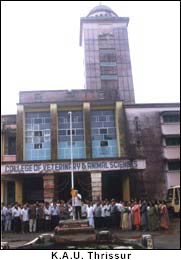|
 The Kerala
Agricultural University came into existence on 24 February 1971. The
Governor of Kerala is the Chancellor and the Minister for Agriculture
the Pro-Chancellor of the university. The supreme authority of the
University is the General Council and the chief executive body is the
Executive Committee. The Vice-Chancellor is the principal executive
and academic officer of the University, who is assisted by the
Registrar, the Comptroller, Deans of the Faculties, the Directors of
Research, Extension, Physical Plant, Students’ Welfare, and the
Librarian. In addition, the Director of Academic and Post-graduate
Studies assists the Vice-Chancellor in academic affairs. The Kerala
Agricultural University came into existence on 24 February 1971. The
Governor of Kerala is the Chancellor and the Minister for Agriculture
the Pro-Chancellor of the university. The supreme authority of the
University is the General Council and the chief executive body is the
Executive Committee. The Vice-Chancellor is the principal executive
and academic officer of the University, who is assisted by the
Registrar, the Comptroller, Deans of the Faculties, the Directors of
Research, Extension, Physical Plant, Students’ Welfare, and the
Librarian. In addition, the Director of Academic and Post-graduate
Studies assists the Vice-Chancellor in academic affairs.
The university has 10
constituent colleges, six Regional Agricultural Research Stations, 26
Research Stations, three Centres of Advanced Studies, the Central
Training Institute, the Communication Centre, and five Krishi Vigyan
Kendras.
In four faculties
(agriculture, Veterinary and animal sciences, Fisheries and
Agricultural engineering) with 56 departments, the university offers
under-graduate and post-graduate programmes at Masters as well as
Doctoral levels.
The major research
contributions are: biological control of Salvinia molesta using
Cyrtogagous salvinia; release of more than 100 varieties of crops
including coconut, pepper and cocoa hybrids and two nationally
acclaimed breeds of poultry (Athulya and Gramalekshmi);
standardization of protocols for large- scale multiplication by
in-vitro techniques in several crops; conservation of the near extinct
Vechur cow; development of commercially viable technology for the
hatchery production of seeds of the giant fresh-water prawn (Macrobrachium
rosenbergii); designing and development of a simple coconut-husking
tool; development of a cell-culture duck plague vaccine; and
standardization of chemical tranquilization procedure for control of
elephants and other captive and wild animals.
The university has five Krishi Vigyan
Kendras. The university started the single-window approach for
technology transfer through Agricultural Technology Information
Centres.
|